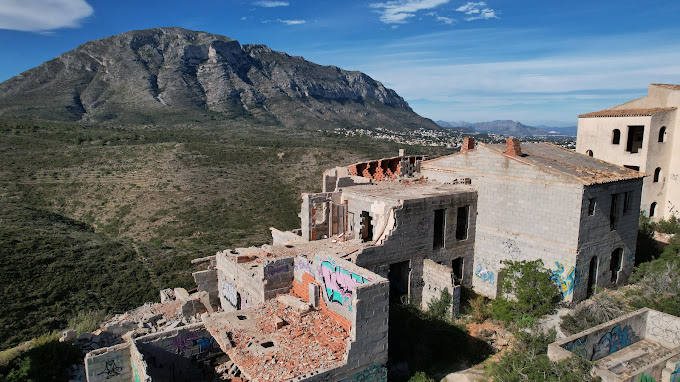Nestled along the picturesque coastline of Spain's Costa Blanca lies Denia, a vibrant port city known for its stunning beaches, historical castle, and the lush Montgó Mountain that towers over it. Yet, beyond the bustling marinas and lively streets, there exists a lesser-known part of Denia that whispers tales of the past, an area that stands in stark contrast to the city’s otherwise lively character: the ghost town of Denia.
The Origins of the Ghost Town
The story of Denia's ghost town begins in the early 20th century, a period marked by industrial expansion and the promise of prosperity. The area, initially thriving with agriculture and small-scale industries, witnessed a surge in population as families moved in, drawn by the lure of employment and a better life. However, the boom was short-lived. The town’s descent into desolation can be traced back to a combination of economic decline, natural disasters, and a series of unfortunate events that led to its abandonment.
The Descent into Silence
The first blow came with the economic downturn in the mid-20th century. The local industries, unable to compete with larger markets, began to falter. This economic hardship was compounded by a severe drought that hit the region, crippling the agricultural sector that many of the town's residents relied upon. The final nail in the coffin was a devastating flood in the late 20th century, which destroyed much of what was left of the town’s infrastructure. These series of events led to a mass exodus, with residents leaving in search of better opportunities, leaving behind empty homes and a silence that would come to define the area.
The Present-Day Ghost Town
Today, the ghost town of Denia stands as a stark reminder of what once was. The streets, once filled with the laughter of children and the hustle and bustle of daily life, now lie silent. Houses that once echoed with the sounds of families now stand empty, with the passage of time visible in their crumbling facades and overgrown gardens. The local church, which once served as the heart of the community, now watches over the town, its bell tower standing silent amidst the ruins.
Despite its desolation, the ghost town has become an intriguing destination for the more adventurous travelers. Photographers and history enthusiasts are drawn to its eerie beauty and the stories that lie behind its decay. The contrast between the vibrant life in Denia and the silent desolation of the ghost town is striking, offering a poignant reflection on the impermanence of human endeavors.
The Efforts for Preservation
Recognizing the historical and cultural significance of the ghost town, local authorities and preservationists have begun efforts to protect and preserve the area. There are talks of restoring certain buildings to serve as a museum or cultural center, which would not only preserve the history of the town but also provide an educational resource for visitors and locals alike. These efforts aim to breathe new life into the ghost town, transforming it from a symbol of abandonment into one of resilience and memory.
The Legacy of the Ghost Town
The ghost town in Denia serves as a powerful reminder of the cyclical nature of history and the resilience of communities in the face of adversity. It tells a story of growth and decline, of hope and loss, and of the enduring spirit of those who once called it home. For visitors, it offers a unique glimpse into the past, allowing them to walk through the remnants of history and ponder the stories that each ruined building and silent street might tell.
Conclusion
The ghost town of Denia is more than just a collection of abandoned buildings; it is a testament to the ever-changing fortunes of human settlements. Its silent streets and crumbling structures speak volumes about the impact of economic shifts, natural disasters, and the passage of time on communities. As efforts to preserve and possibly rejuvenate the area continue, the ghost town stands as a poignant reminder of the past, offering lessons and reflections for both locals and visitors alike. In the shadow of Denia's bustling city life, the ghost town remains a fascinating, if eerie, monument to the fragility and resilience of human endeavour.
Frequently Asked Questions (FAQs)
What caused the abandonment of the ghost town in Denia?
The ghost town in Denia was abandoned due to a combination of economic decline, severe drought, and a devastating flood that crippled the local industries and agriculture, leading to a mass exodus
Can visitors explore the ghost town in Denia?
Yes, visitors can explore the ghost town in Denia. It has become a destination for adventurous travelers, photographers, and history enthusiasts drawn by its eerie beauty and historical significance
Are there any preservation efforts for the ghost town in Denia?
Local authorities and preservationists are working on efforts to protect and preserve the ghost town, including proposals to restore certain buildings for use as a museum or cultural center
What makes the ghost town in Denia worth visiting?
The ghost town offers a unique glimpse into the past, its silent streets and crumbling structures providing a poignant reflection on the impermanence of human endeavors and the resilience of communities
How does the ghost town in Denia contrast with the rest of the city?
The ghost town stands in stark contrast to the vibrant, bustling life of Denia, offering a striking reflection on the cyclical nature of history and the impact of economic and natural challenges on communities
